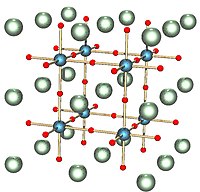
Photo from wikipedia
Hybrid organic-inorganic perovskites (HOIPs) have garnered widespread interest, yet stability remains a critical issue that limits their further application. Compared to their three-dimensional (3D) counterparts, two-dimensional (2D)-HOIPs exhibit improved stability.… Click to show full abstract
Hybrid organic-inorganic perovskites (HOIPs) have garnered widespread interest, yet stability remains a critical issue that limits their further application. Compared to their three-dimensional (3D) counterparts, two-dimensional (2D)-HOIPs exhibit improved stability. 2D-HOIPs are also appealing because their structural and optical properties can be tuned according to the choice of organic ligand, with monovalent or divalent ligands forming Ruddlesden-Popper (RP) or Dion-Jacobson (DJ)-type 2D perovskites, respectively. Unlike RP-type 2D perovskites, DJ-type 2D perovskites do not contain a van der Waals gap between the 2D layers, leading to improved stability. However, bifunctional organic ligands currently used to develop DJ-type 2D perovskites are limited to commercially available aliphatic and single-ring aromatic ammonium cations. Large conjugated organic ligands are in demand for their semiconducting properties and their potential to improve materials stability further. In this manuscript, we report the design and synthesis of a new set of larger conjugated diamine ligands and their incorporation into DJ-type 2D perovskites. Compared with analogous RP-type 2D perovskites, DJ 2D perovskites reported here show blue-shifted, narrower emissions and significantly improved stability. By changing the structure of rings (benzene vs thiophene) and substituents, we develop structure-property relationships, finding that fluorine substitution enhances crystallinity. Single-crystal structure analysis and density functional theory calculations indicate that these changes are due to strong electrostatic interactions between the organic templates and inorganic layers as well as the rigid backbone and strong π-π interaction between the organic ligands themselves. These results illustrate that targeted engineering of the diamine ligands can enhance the stability of DJ-type 2D perovskites.
Journal Title: Journal of the American Chemical Society
Year Published: 2021
Link to full text (if available)
Share on Social Media: Sign Up to like & get
recommendations!